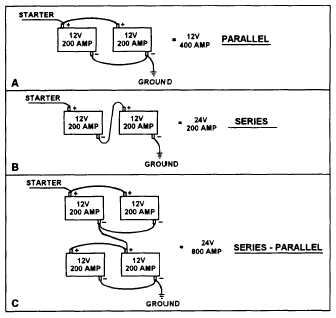during peak operation, the battery helps the generator
supply current; and (3) during normal operation, the
generator supplies all current and recharges the battery.
In both electrical systems, the battery starts the
electrical circuit that supplies the spark to start the
engine.
The engine then drives the generator or
alternator that produces current to take over the
operation of the ignition, lights, and accessory loads.
The battery also supports the generator or alternator
during peak operation when the electrical loads are
excessive. But once the engine is started the generator
or alternator is the “work horse,” providing current to
the ignition and accessory circuits. The generator
supplies current as long as the engine is at speed and
running. When the engine slows down or stops, the
battery takes over part or all of the load.
STARTING CIRCUITS
High voltage is often necessary to ensure sufficient
starting power due to the high compression ratios of
some diesel engines. Three systems are used to increase
either the voltage or amperage to accomplish this task
These are parallel, series, and series-parallel systems.
Parallel System
An example of a parallel system, as shown in figure
4-3, view A, is two 12-volt, 200-amp batteries are
connected from the starter to the positive terminal of one
battery to the positive terminal of the second battery.
The negative side of the batteries are connected from the
ground to the negative terminal from one battery to the
negative terminal of second battery. This system
provides 12 volts and 400 amps, providing more
amperage for starting.
Series System
An example of a series system, as shown in figure
4-3, view B, is two 12 volt, 200-amp batteries are
connected from the positive terminal of one battery to
the negative terminal of the second battery. The
remaining positive terminal is connected to the starter
and the remaining negative temninal is connected to the
ground. This system provides 24 volt and 200 amps,
providing more volts for starting.
Series-Parallel System
A series-parallel system provides a series
connection of the batteries for starting and a parallel
Figure 4-3.—Starting circuits.
connection for normal operation. An example of a
series-parallel system is when two sets of parallel
batteries, as shown in figure 4-3, view C, are connected
in series and the negative terminal from one set of the
batteries is connected to the positive terminal of the
other set. This system provides 24 volts and 800 amps.
This combination is used for cranking large construction
equipment.
CAUTION
Use extreme care when jump starting is
required. Hooking up jumper cables from a
24-volt system to a heavy-duty 12-volt system
can cause severe battery damage, starter
destruction, or even an explosion. If you are
unsure of the starting circuit, get help from the
mechanic field crew for assistance.
LIGHTING SYSTEM
The lighting system on automotive, construction,
and weight-handling equipment includes the lamps and
bulbs, clearance lights, side marker lights, reflectors,
taillights and brake lights, auxiliary lights, and fuses.
Standards for lights on vehicles are outlined in the
Federal Motor Carrier Safety Regulations Pocketbook.
The manufacturer provides equipment with an
electrical system that supports the lighting circuits. Part
of your prestart responsibility is to ensure the lights on
your equipment work and are clean of dust and dirt. A
4-3


